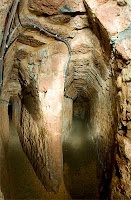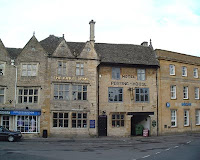What Lies Beneath?
 Now here is an idea for a story setting! I was reading my English Heritage magazine and came across a reference to the medieval vaulted passageways that lie beneath the City of Exeter. Apparently they were built to supply fresh drinking water to the city and are unique in the UK. These days they are a tourist attraction.
Now here is an idea for a story setting! I was reading my English Heritage magazine and came across a reference to the medieval vaulted passageways that lie beneath the City of Exeter. Apparently they were built to supply fresh drinking water to the city and are unique in the UK. These days they are a tourist attraction.Exeter's early water supply came from springs and the Roman garrison sourced water from two local springs and brought it into the city via an aqueduct. In the Middle Ages, Exeter became a great ecclesiastical centre and the earliest passage was built between 1346 and 1349 to serve the city's cathedral. The water pipes ended at a fountain in Cathedral Close that supplied clean water to Exeter's clergy. The same stonemasons who worked on the magnificent cathedral were also tasked with constructing the vaulted underground passageways and their masons' marks can be seen on the walls. The tunnels were constructed by digging a trench in the clay, lining it with cut stone and adding capping stones.
The continued growth of the city meant that the supply of clean water was never enough for the whole population and this resulted in the construction of a second tunnel known as The City Passage between 1492 and 1497. Wealthy merchants engaged in the woollen trade wanted their own water supply, one that was not controlled by the cathedral authorities. The wealthiest residents could afford for the water to be piped directly to their homes but for everyone else, it was dispensed through an ornate public fountain called The Great Conduit, at the junction of South Street and the High Street.
whole population and this resulted in the construction of a second tunnel known as The City Passage between 1492 and 1497. Wealthy merchants engaged in the woollen trade wanted their own water supply, one that was not controlled by the cathedral authorities. The wealthiest residents could afford for the water to be piped directly to their homes but for everyone else, it was dispensed through an ornate public fountain called The Great Conduit, at the junction of South Street and the High Street.
 whole population and this resulted in the construction of a second tunnel known as The City Passage between 1492 and 1497. Wealthy merchants engaged in the woollen trade wanted their own water supply, one that was not controlled by the cathedral authorities. The wealthiest residents could afford for the water to be piped directly to their homes but for everyone else, it was dispensed through an ornate public fountain called The Great Conduit, at the junction of South Street and the High Street.
whole population and this resulted in the construction of a second tunnel known as The City Passage between 1492 and 1497. Wealthy merchants engaged in the woollen trade wanted their own water supply, one that was not controlled by the cathedral authorities. The wealthiest residents could afford for the water to be piped directly to their homes but for everyone else, it was dispensed through an ornate public fountain called The Great Conduit, at the junction of South Street and the High Street. During the English Civil War the passage under the wall was thought to be dangerous, a way in which enemy troops could infiltrate the city. The lead was removed and used for casting into bullets and the passages were filled with rubble. Despite this Exeter, which started the war as one of the few parliamentary-held towns in the Royalist south west, fell to the Royalists in 1643 and remained under their control until almost the end of the war.
In 1655, after the war ended, the passages were repaired and the water supply restored. However, the water supply for the fast growing city was proving to be inadequate and in 1694 a wheel driven 'water engine' was built which pumped water through wooden pipes to a tank at the rear of the Guildhall.
 Between 1805 and 1833 James Golsworthy was employed to maintain and improve the water supply and in 1811 he introduced the first cast iron pipes in England. The system was used until 1857. Five hundred years after they were first built, the passages were put to a completely different but equally vital use during World War II when part of the tunnel network served as a shelter from German bombing raids.
Between 1805 and 1833 James Golsworthy was employed to maintain and improve the water supply and in 1811 he introduced the first cast iron pipes in England. The system was used until 1857. Five hundred years after they were first built, the passages were put to a completely different but equally vital use during World War II when part of the tunnel network served as a shelter from German bombing raids. So now here is a challenge. How would you incorporate Exeter's underground passages into a book? Would it be in a time slip story as a way to step back into the 14th century? Or in a paranormal, as the hiding place for vampires? Is it somewhere a Regency heroine might be trapped, or a route she uses to escape from her chaperone in order to do something more exciting than attend balls and assemblies? What lies beneath?



Comments
I am with Jan, smugglers and spies would be great, but so would a time slip (time travel in the US) novel!
Thanks for another fantastic post!